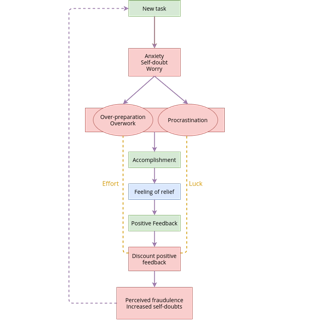Recently, I had quite an interesting conversation with a few fellow mates from college. Now, here is a group of freshly graduated therapists confronted with the realities of beginning their practice, resulting in some degree of anxiety and uncertainty. In our conversations, a shared theme of feeling inadequate and questioning one’s competence over and over arose.
This common sentiment was, in fact, linked to a widely discussed phenomenon. Impostor syndrome is a term popularly used to describe carrying a heavy feeling of not being good enough, which in turn can hinder the individual’s ability to acknowledge and recognize their successes.
Despite supporting evidence, these successes are often attributed to external factors such as luck or chance, making themselves the impostor or fraud in their narrative.
While the main contributors to this syndrome could extend from growing up in an environment that reinforced one’s internal message of ‘not being good enough’ to being caught in a loop of comparison, the impact of it still remains high.
In the dynamic workplace environment, this sneaky syndrome can cause trouble. This internalized sense of being an impostor can easily lead to a cycle of anxiety, fear of exposure, and overworking to prove oneself, causing burnout.
Dr. Pauline Clance initially coined the term in 1978 and defined it as “an internal experience of intellectual phoniness’. It is interesting to note that Dr.Pauline believed Impostor Phenomenon is not “a pathological disease that is inherently self-damaging or self-destructive”. Rather, it interferes with the psychological well-being of a person.
An infographic from this study encapsulates the cyclic nature of this phenomenon.

Having personally experienced the clutches of impostor syndrome, the narrative therapist in me visualizes it to be a big green furry monster, most likely named Kevin, drolling around and dragging his heavy club across the cobblestone walls of my mind.
Here, giving my impostor syndrome a name/label (i.e., Kevin) helped me step outside and de-associate myself from this feeling of fraudulence. I began to see Kevin as another opinionated monster who likes to make his occasional remarks but as someone, I have power over.
Shaping my narrative in turn, helped me recognize moments where the monster had told me I wasn’t good enough to work on a certain project, or when it had amplified a minor issue to seem like a catastrophe.
Reshaping your story or narrative is a well-known intervention often used by narrative therapists in their practice. While there are many evidence-backed strategies to combat Impostor syndrome, therapy can provide valuable insights into your underlying narratives contributing to this phenomenon. Narrative therapy is an approach that emphasizes the importance of the stories we tell ourselves and how these narratives tend to shape our perception of reality.
Interestingly, research shows that initially, this syndrome was often attributed to explain the lived experiences of high-achieving women failing to take into account the role of systemic-level concerns such as gender bias, whose discriminating nature invokes a similar feeling of not being good enough that mirrors impostor syndrome in women.
If you are an organization looking to help your employees tackle this, your DEI efforts must not be concentrated only on an individual level. Your work environment actively contributes to how you feel and your overall sense of belongingness, which is why it is imperative for organisations to focus on creating an environment that fosters a variety of leadership styles and in which diverse racial, ethnic, and gender identities are well-represented.
To build an inclusive workplace and dig deeper into impostor syndrome, write to us at hello@serein.in


